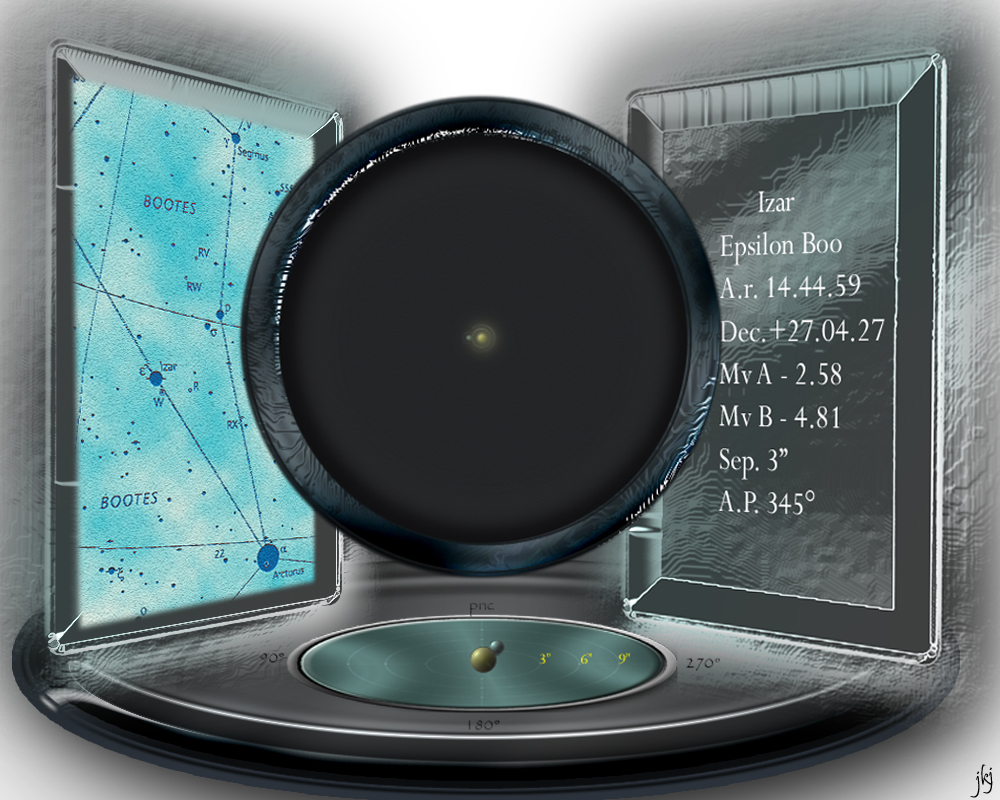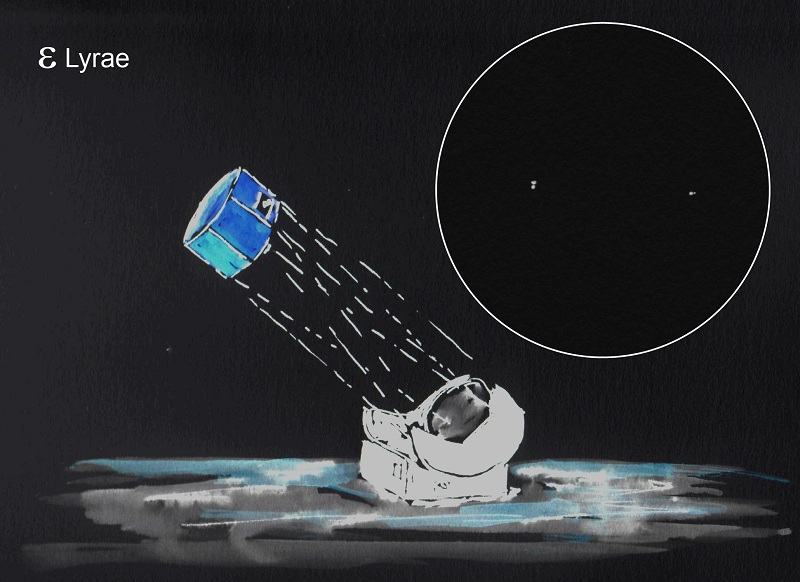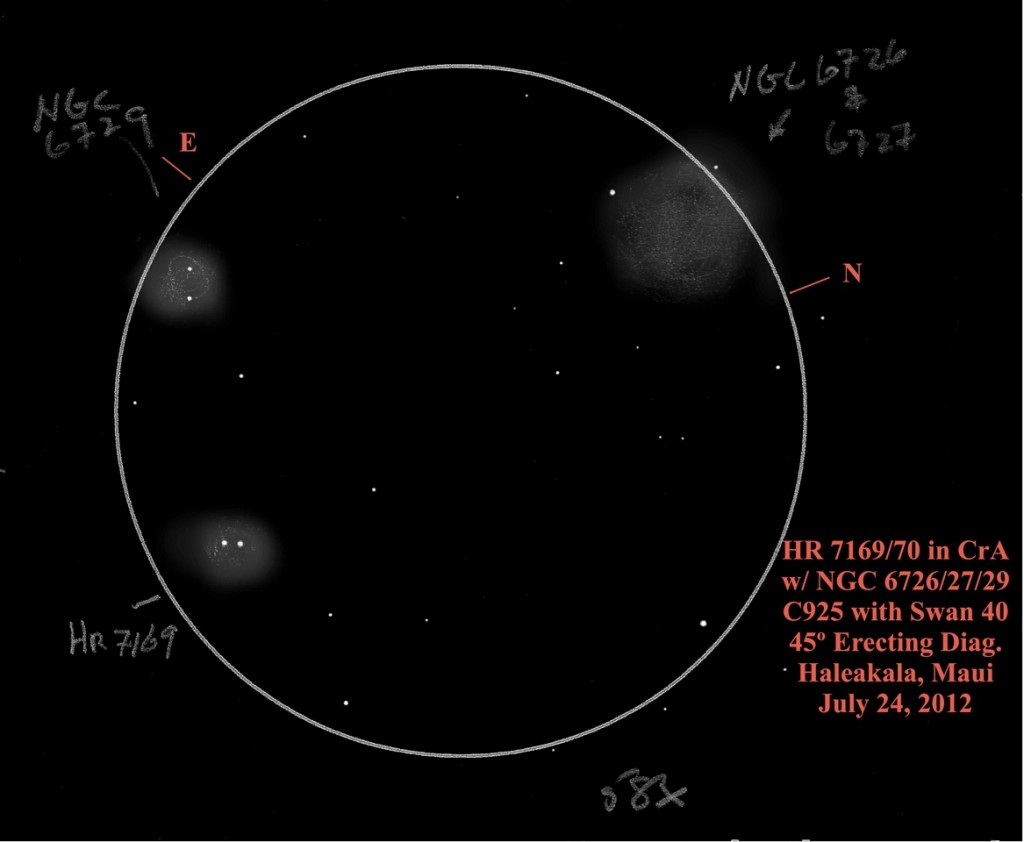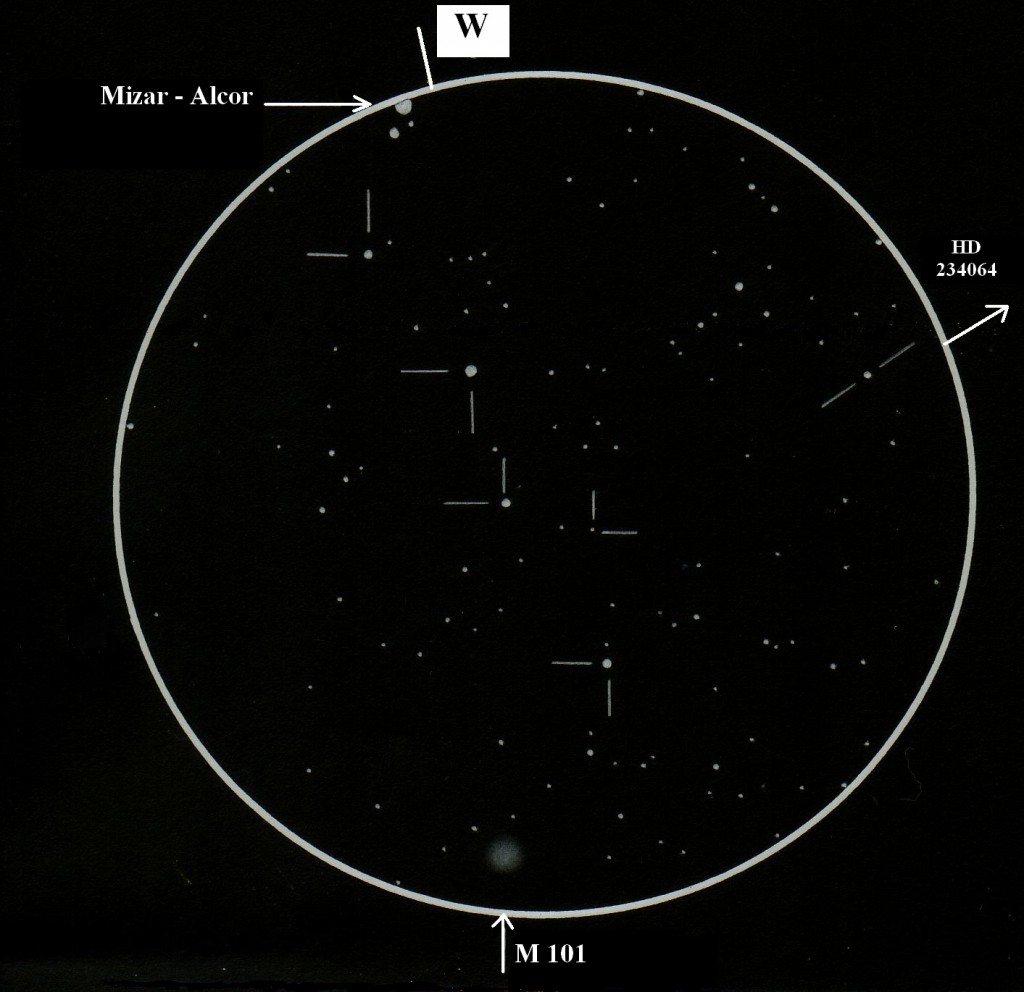
Izar
Object Type: Double Star
Observation date: 07-27-2013
Location: Rome (Italy)
Telescope: Xlt 127/1250 Omni Celestron
156x + barlow 2.5x
Media: Digital with Photoshop (08-20/2013)

Hello astro-sketchers, here my last contribution…
Object Name (Epsilon1/2 Lyrae the Double double)
Object Type (Multiple Star)
Location (Château de Berne – Provence – France)
Date (May 8th)
Media (watercolor and ink, inverted while scanning)
Epsilon Lyrae, the “double-double” star, seen in the 450mm Dobson of my friend Philippe.
During this 4th yearly animation made in the “Château de Berne”, a nice vineyard domain in Provence, I had the opportunity to sketch this difficult multiple star.
The northern star is called ε1 and the southern one is called ε2; they both lie around 160 light years from Earth and orbit each other. In this big 450mm eye, both stars of the binary can be further split into binaries; that is, the system contains two binary stars orbiting each other. The component stars of ε1 have magnitudes of 4.7 and 6.2 separated by 2.6″ and have an orbital period that can only be crudely estimated at 1200 years, which places them at roughly 140 AU apart. The component stars of ε2 have magnitudes 5.1 and 5.5 separated by 2.3″, orbit perhaps half that period. ε1 and ε2 themselves are not closer than 0.16 light years apart, and would take hundreds of thousands of years to complete an orbit.
I made the watercolor taking into account the further inversion needed, that means black for white and orange for blue, for example.
Astro sketch website : http://astro.aquarellia.com
Clear sky to you all !
Michel Deconinck

Object Name: Double Star HR 7169 & 7170 in Corona Australis with NGC 6726, 6727 & 6729.
Object Type: Double Star with three Bright Nebulae
Location: The Summit of Haleakala on Maui at 10,000 ft. elevation
Date: July 24, 2012
Media: Light pencil on white paper, scanned to GIMP, and color inverted, Labelled in Mac Preview.
Notes: This sketch was executed with a Celestron C925 on a CGEM with a Swan 40mm EP and a Williams Optics 45º erecting prism diagonal at 58X. The wind was 10mph, Temp: 47ºF, Humidity 24% under a first quarter moon at 2130. The Lit. Rho is 12.8″, Theta is 280º. I measured the pair with a Meade 12mm Astrometric EP and obtained an average Rho of 14.8″, and average Theta of 218º.
I am interested in the nebulosity of the three NGC objects that are included in the field of view. I plotted 25 field stars including one outside the F.O.V. to the west and two outside the F.O.V. to the WSW.
Steve McGaughey
Haleakala Amateur Astronomers

Object: Latysev 2 (possible moving cluster, UMa)
Date: 14. March 2007.
UT.: –
Equipment: 10×80 TZK binocular
Mag.: 10x
FOV: 6˚ x 6˚
Observer: János Gábor Kernya
Location: Sükösd, Hungary
Latysev 2:
„This is a possible moving cluster of seven stars, first suggested by Latyshev (1977). It was identified by considering the space motion of several nearby (GJ, or Gliese Catalogue) stars in this area. The stars cover an area of 3˚ by 3,5˚, including primarily the line of four bright stars between ζ UMa (Mizar and Alcor) and the galaxy M101. These are 81, 83, 84 and 86 UMa. The other 3 stars are HR 5169, HD 234064, and HD 234073. The magnitude range is from V = 4.66 (83 UMa) to V = 10.3 (HD 234073), summing to V = 3.67 and B = 4.05.
Brent A. Archinal – Steven J. Hynes: Star Clusters
(Willmann-Bell, Inc.)

Dear Asod,
I send you hereby my sketches of double stars mainly from Virgo, Aquila, Bootes and Lyra. I have observed these double (and multiple) systems on the 14th and on the 28th July. These are all different doubles (or multiples), with different separations from 1,5” to 200”, with different colours. But all can be observed with a small telescope like mine.
Equipment used: 130/650, 26x, 52x, 93x, 130x (different eyepieces).
Media: White paper, graphite pencil, inverted in Photoshop
Date: 14th and 28th July 2012
Place: Budapest, Hungary
Clear Skies,
Judit

– M20 – The Trifid Nebula (NGC 6514)
– Emission/Reflection Nebula
– Apparent Magnitude: 6.3
– Itajobi, Brazil
– July 27th, 2011
– 01h00 (U.T.)
– 2B 0.5mm graphite pencil on white paper
– 180mm dobsonian reflecting telescope
– 20mm Super Plossl eyepiece
– Magnification: 54 x
– Seeing: Antoniadi 1 (fine)
– NELM: 5.5
As I’ve already said, July 2011 was a productive month for me. I could observe and sketch many objects as I had never done before. Conditions were exceptional: no clouds, fair wind and pleasant temperature. That night I pointed my telescope to many objects. One of them was M20. Close to the Zenith, it was clearly seen. The dark paths in the Nebula were confusing, though. Only with averted vision I was able to notice the feature thoroughly, so it was a tough job to put it down on the paper. That was my best observation of The Trifid Nebula, I hope you like it.
Clear sky to everyone
Rodrigo Pasiani Costa